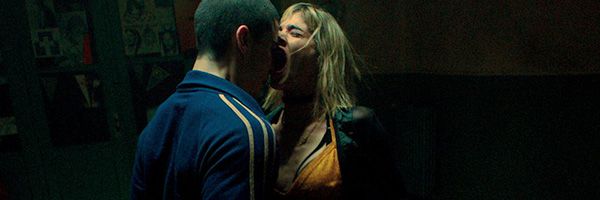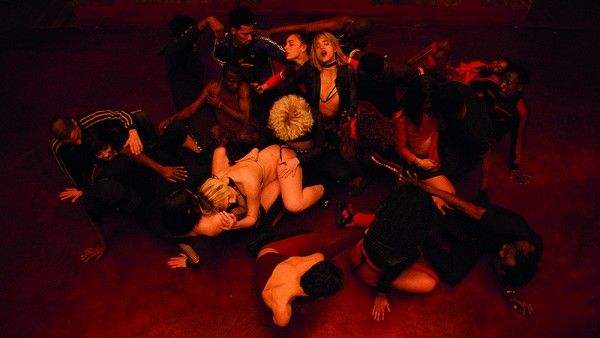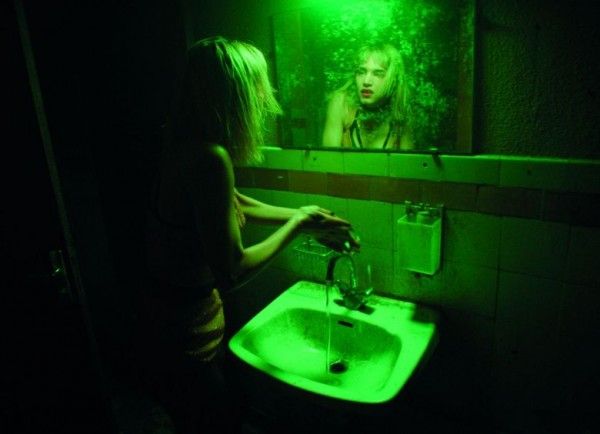Note: This is a re-post of our Climax review from the 2018 Cannes Film Festival. The film is now playing in limited release.
It used to be that a massively long one-shot scene in a movie was a big deal. Today the advent of digital cameras has tempered that a bit. Sure, crafting an extended take can demand a complicated set of marks for actors and a camera operator, but because it’s seen so often in all sorts of media it rarely gets anyone that excited anymore. There are exceptions, however, as creative auteurs continue to push the boundaries of the medium. Two filmmakers brought a radically fresh perspective to the concept at the 71st Festival de Cannes, Bi Gan’s Long Journey Into Night which features a 55-minute “one shot” sequence (clearly stitched together at a few points) and Gaspar Noé’s feature Climax which features at least six no-cut sequences. It’s the latter, acquired by A24 less than a day after its premiere at the Cannes Film Festival, that will truly overwhelm you.
The plot is a pretty simple one. It’s 1996 and a dance troupe has been put together to tour the United States in order to demonstrate how fierce the underground dance scene is back in France. The members are a mix of straight, gay, lesbian, black and Hispanic French twentysomethings with a random German thrown in for good measure (or maybe she’s Dutch or Russian, whatever). The film begins though with a series of video interviews for the prospective candidates as they answer questions the troupe’s creative director, Emmanuelle (Claude Gajan Maull), asks off camera. This portion of the film isn’t groundbreaking, but with such a large cast of characters helps set up their storylines before the real action begins. Cut to a series of title cards, the beat drops and the dancing begins.
Noé’s previous work such as Enter the Void and his last film, the flawed Love, have all featured stunning visual moments. You can criticize his interview soundbites, but he has a masterful eye. When the image cuts from the title cards he starts with a wide shot of the entire troupe dancing to a choreographed number. There are 21 dancers and the number is at least 10 minutes long. It’s simply phenomenal with sweeping camerawork (operated by Noé, no less) that mesmerizes. You may not have a particular affinity for dance or house music and be over any nostalgia for the ‘90s (although beyond the lack of phones this is could have easily taken place today), but you can bet this will make you realize how basic and bloated any of the numbers you loved in The Greatest Showman really were.
Once the number ends the troupe cheers and the afterparty begins. They’ve been living in a former boarding school in the middle of nowhere rehearsing for weeks and with the numbers locked down this is their chance to unwind before they hit the road. Emmanuelle has made some Sangria and Daddy (Kiddy Smile, also oversaw the music) has the beats rolling. Noe drops the one-shot here and there as he tries to set up the conflicts and give (almost) every dancer their moment.
We learn that everyone regardless of gender wants to hook up with David (Romain Guillermic), and, boy, he’s certainly taking full advantage. There’s Selva (Sofia Boutella, Star Trek Beyond) who doesn’t realize David is cheating on her. There are the two lesbians who are having couple issues, Ivana (Sharleen Temple) and Gazelle (Thea Carla Schott). There’s Rocket (Kendall Mugler) the queen of high heel dancing and a brother and sister duo (actor names unclear) who might be a little too familiar with each other for comfort. And there’s even Emmanuelle’s young son who is quickly taken to bed now that the festivities are underway.
Noé has described this half of the film as “heaven” and he gifts us with another long one-shot dance sequence shot from overhead. Every member of the troupe gets a shot at the spotlight and one character in particular, unclear due to lack of clarity in the film’s production notes, does a death drop where he hangs in the air that made this critic simply gasp (it’s Jordan-esque). The director than ends this portion of the picture with a series of mid-film credits. It’s a specific demarcation because “hell” is about to begin.
Unknown to the dancers, someone has spiked Emmanuelle’s punch (likely LSD) and when it kicks in? Oh, my. Each member of the troupe reacts to it in different ways. Some horrifyingly, some deadly and some euphorically. There is a slight mystery about who is responsible, but it’s the fate of each character battling their haze that really keeps your attention.
The Argentinian born director never flips the perspective to show the events through the characters eyes as he has done in some of his previous films. Here, he only follows them through their horror in the space itself. That means returning to extremely long takes (one potentially over 20 min long) as he flips the camera in all manner of angles to capture the paranoia setting in for many.
This is also the portion of the film that will disturb many. The visuals, sound design and reactions by many of the characters are intense. That being said, Emmanuelle’s son is also still in the building and how he becomes intertwined in the events will cause some consternation. It’s also during this portion where Noe’s vision starts to get a tad away from him. The sequences are frantic and often feel never-ending. That’s intentional in some respects and you can’t argue that it doesn’t create a unique, visceral reaction, but it’s a relief when things finally calm down.
The picture is aided by some stunning lighting from Noé’s longtime cinematic collaborator Benoit Debie and LA based choreographer Nina McNeelly. Noé also benefits from Kiddy Smile helping him cast many of the actors from the Underground Paris Ballroom scene (dancers with little previous acting ability, but you’d never know it) and a phenomenal lead performance by Boutella. There’s also a spot-on soundtrack featuring classics such as Serrone’s “Supernature” and “Pump Up The Volume” by M/A/R/R/S/.
The biggest compliment you can give Climax though is that it’s so essentially captivating that despite its horrors, you want to take a quick bathroom break, get back in your seat and watch it all over again. And maybe once more after that too.
Grade: A-



